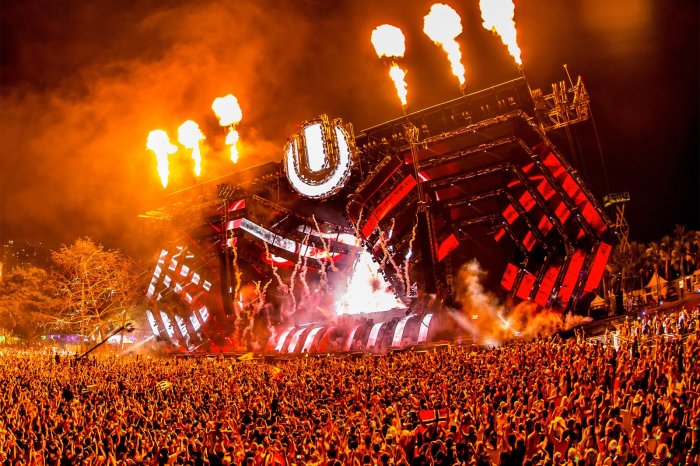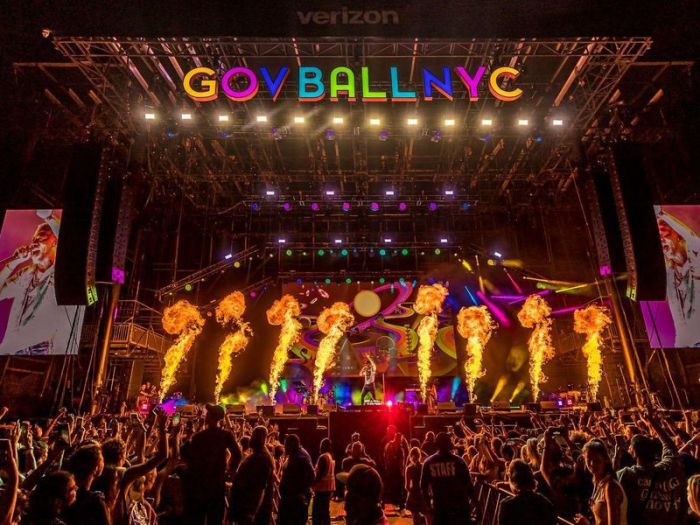America’s Biggest Music Festivals represent a vibrant tapestry of music, culture, and commerce. From the electrifying energy of EDM gatherings to the soulful sounds of country concerts and the raw power of rock festivals, these events draw millions annually, shaping not only the landscape of American music but also contributing significantly to local economies and social dynamics. This guide delves into the multifaceted world of America’s largest music festivals, exploring their ranking metrics, genre-specific experiences, geographical impact, and lasting legacies.
We’ll dissect what truly defines “biggest,” considering factors like attendance, economic impact, media buzz, social media engagement, and the prestige of the artist lineup. We’ll then explore the diverse musical genres represented, examining the unique characteristics of each and the demographics of their respective audiences. Furthermore, we’ll analyze the geographical distribution of these mega-events, considering the influence of location on a festival’s overall appeal.
Finally, we’ll assess their broader economic and social impact, both positive and negative, highlighting the evolution of these colossal celebrations of music and community.
Top Festivals by Genre: America’s Biggest Music Festivals

Understanding the landscape of major music festivals requires a genre-specific approach. Different genres attract distinct audiences, resulting in unique festival experiences. Analyzing these differences reveals valuable insights into consumer behavior and market trends within the music industry. This analysis focuses on five prominent genres: Pop, Rock, Electronic Dance Music (EDM), Country, and Hip Hop, highlighting leading festivals and their respective audience demographics.
Pop Music Festivals
Pop music festivals are characterized by their broad appeal, attracting a diverse age range and demographic. These events often feature chart-topping artists and deliver a high-energy, visually stunning experience.
- Coachella Valley Music and Arts Festival (Indio, CA): Coachella consistently features A-list pop stars alongside other genres, drawing a young, affluent, and fashion-conscious crowd. The festival’s location and luxurious amenities contribute to its upscale image.
- Lollapalooza (Chicago, IL): A multi-genre festival with a strong pop presence, Lollapalooza attracts a large and diverse audience, ranging from teenagers to young adults. Its urban setting and diverse lineup contribute to its broad appeal.
- Summerfest (Milwaukee, WI): One of the world’s largest music festivals, Summerfest boasts a diverse lineup, including many pop acts, appealing to a broad demographic across various age groups and income levels. Its long history and location in a major city contribute to its large attendance.
Typical audience demographics for pop festivals include a wide age range, predominantly millennials and Gen Z, with a higher concentration of females. Income levels vary, but generally skew towards the middle and upper-middle class.
Rock Music Festivals
Rock music festivals offer a more intense, often nostalgic, experience. They attract a dedicated fan base, often spanning multiple generations united by a shared love for the genre’s history and evolution.
- Download Festival (Donington Park, UK): Download is known for its hard rock and metal lineups, attracting a predominantly male audience, often aged 18-45, with a passion for heavy music and a strong sense of community.
- Rock in Rio (Various Locations): This massive festival, held in various cities around the world, attracts a broad rock audience, encompassing different subgenres and age groups, unified by their love for rock music’s diverse styles and energy.
- Austin City Limits Music Festival (Austin, TX): While not exclusively rock, ACL features a substantial rock presence, attracting a diverse audience, including younger crowds alongside older fans who appreciate the festival’s blend of genres and its vibrant atmosphere.
The typical rock festival audience tends to be slightly older than the pop festival audience, with a more even gender split. Income levels are generally diverse, reflecting the broad appeal of the genre across different socioeconomic backgrounds.
Electronic Dance Music (EDM) Festivals
EDM festivals are known for their immersive experiences, often featuring elaborate stage productions, lighting, and special effects. The audience is typically young, energetic, and tech-savvy.
- Ultra Music Festival (Miami, FL): Ultra is a globally renowned EDM festival attracting a massive international audience, predominantly young adults aged 18-35, with a strong interest in electronic music culture and a willingness to embrace new trends.
- Tomorrowland (Boom, Belgium): This festival is considered one of the world’s largest and most prestigious EDM events, drawing a largely international crowd of young adults, many of whom are affluent and passionate about the genre’s diverse subgenres.
- Electric Daisy Carnival (Las Vegas, NV): EDC is a massive, multi-day event that features a wide array of EDM artists, drawing a diverse audience, primarily young adults, who are attracted by its vibrant atmosphere, advanced stage production, and cutting-edge music.
The EDM festival audience is largely young adults, with a fairly even gender split. Income levels tend to be diverse, although the festival’s high ticket prices often suggest a higher-than-average income level among attendees.
Country Music Festivals
Country music festivals celebrate a genre rooted in tradition, yet constantly evolving. The audience tends to be older than those attending pop or EDM festivals, with a strong sense of community and shared cultural values.
- Stagecoach California Country Music Festival (Indio, CA): Stagecoach, held in the same location as Coachella, attracts a largely older audience than its counterpart, with a strong emphasis on traditional and contemporary country music, drawing fans who appreciate the genre’s history and its modern iterations.
- CMA Music Festival (Nashville, TN): This festival, held in the heart of country music, draws a massive crowd of country music enthusiasts of all ages, highlighting the genre’s broad appeal across generations.
- Country Thunder (Various Locations): This traveling festival attracts a diverse crowd, showcasing country music’s reach across various demographics, appealing to both longtime fans and younger generations embracing the genre.
The typical country music festival audience skews older than other genres, with a slightly higher proportion of females. Income levels vary, reflecting the genre’s broad appeal across different socioeconomic backgrounds.
Hip Hop Music Festivals
Hip Hop festivals showcase the dynamism and cultural influence of the genre. The audience is typically diverse, reflecting the genre’s global reach and impact on popular culture.
- Rolling Loud (Various Locations): Rolling Loud is a globally recognized festival showcasing a wide array of hip-hop artists, drawing a young, diverse, and predominantly male audience, known for its energetic atmosphere and its celebration of hip-hop’s ever-evolving soundscape.
- South by Southwest (SXSW) (Austin, TX): While not exclusively hip-hop, SXSW features a significant hip-hop presence, drawing a young, diverse, and trendsetting audience, reflecting the genre’s influence on broader popular culture.
- Made in America (Philadelphia, PA): This festival, curated by Jay-Z, consistently features top-tier hip-hop artists, attracting a large and diverse audience reflecting the genre’s global appeal and its influence on contemporary music.
The typical hip-hop festival audience is young, diverse in terms of ethnicity and gender, with a slightly higher proportion of males. Income levels are diverse, reflecting the genre’s broad appeal across different socioeconomic backgrounds.
The Evolution of America’s Biggest Music Festivals

America’s music festival landscape has undergone a dramatic transformation since its inception. From humble beginnings as counter-cultural gatherings, these events have evolved into massive, multi-million dollar enterprises, shaping musical trends, influencing societal norms, and leaving an undeniable mark on popular culture. This evolution reflects broader societal shifts, technological advancements, and the ever-changing tastes of music fans.
The Growth and Transformation of Three Major Festivals
Three festivals exemplify this evolution: Woodstock, Coachella, and Lollapalooza. Woodstock, born from a counter-cultural movement, showcased the power of music to unite a generation. Coachella, a relative newcomer, leveraged technology and branding to become a global phenomenon. Lollapalooza, initially conceived as a farewell tour, adapted and thrived by embracing diverse genres and evolving audience expectations. Their distinct trajectories highlight the multifaceted nature of festival development.
Woodstock: A Counter-Cultural Milestone, America’s Biggest Music Festivals
Woodstock, held in 1969, was a pivotal moment in American history. Initially conceived as a small gathering, it unexpectedly attracted hundreds of thousands of attendees, becoming a symbol of peace, love, and the anti-establishment sentiments of the era. Its musical lineup, featuring iconic acts like Jimi Hendrix, Janis Joplin, and The Who, cemented its place in music history. The festival’s chaotic organization, however, highlighted the challenges of managing such a large-scale event, serving as a blueprint (and cautionary tale) for future festivals.
The iconic imagery and lasting cultural impact of Woodstock overshadow its organizational shortcomings, shaping the narrative of music festivals for decades to come. Subsequent attempts to recreate the Woodstock magic have mostly fallen short, underscoring the unique confluence of factors that contributed to its legendary status.
Coachella: The Rise of the Branded Festival
Coachella, launched in 1999, represents a distinctly modern approach to festival curation. From its inception, Coachella prioritized branding, marketing, and leveraging technology to enhance the attendee experience. Its curated lineups, featuring a mix of established headliners and emerging artists across various genres, attracted a younger, more affluent demographic. The festival’s incorporation of art installations, celebrity appearances, and sophisticated social media strategies significantly increased its global reach and cultural impact.
Coachella’s success demonstrates the power of branding and strategic marketing in shaping the modern music festival experience, transforming it into a high-profile, highly lucrative event. Its expansion beyond music, incorporating art and other cultural elements, exemplifies the evolution of the festival from a primarily musical event to a broader cultural experience.
Lollapalooza: Adapting to Changing Trends
Lollapalooza, initially conceived as a farewell tour for Jane’s Addiction in 1991, cleverly transitioned into an annual festival. Its early years focused on alternative rock, reflecting the dominant music trends of the time. However, to ensure longevity, Lollapalooza adapted its programming to incorporate diverse genres, responding to shifts in musical tastes and audience preferences. This adaptability, combined with its expansion to multiple cities, secured its position as a major player in the festival circuit.
Its ability to remain relevant and attract a diverse audience showcases the importance of flexibility and responsiveness to changing trends in the music industry. The festival’s expansion to multiple locations demonstrates the economic viability and widespread appeal of the modern music festival model.
A Timeline of Coachella’s Key Milestones
- : Coachella Valley Music and Arts Festival debuts, showcasing a blend of rock, electronic, and alternative music.
- s: The festival steadily gains popularity, attracting a growing audience and increasingly diverse lineups.
Mid-2000s: Coachella begins to incorporate art installations and expands its branding efforts, enhancing its overall appeal.Late 2000s: The festival’s global reach expands significantly through increased social media engagement and international media coverage.
- s: Coachella becomes a global cultural phenomenon, synonymous with luxury, celebrity appearances, and a curated festival experience. It establishes itself as a major player in the global music festival landscape.
- s: The festival navigates the challenges of the COVID-19 pandemic and adapts its format, showcasing resilience and innovation.
Ultimately, America’s biggest music festivals are more than just concerts; they are powerful economic engines, catalysts for cultural exchange, and unforgettable experiences for millions. Understanding their ranking methodologies, genre-specific nuances, geographical impacts, and evolving histories provides a crucial perspective on their influence on American culture and beyond. From the economic benefits to the social implications, these events leave an indelible mark, shaping trends and forging memories for years to come.
By analyzing the various factors that contribute to their success and impact, we gain a deeper appreciation for the multifaceted world of these massive celebrations.